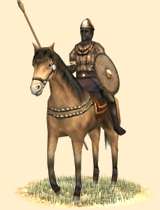Aithiopikoi Hippeis (Ethiopian Cavalry)
 |
Weapons | Defence | Mental | ||||||
|---|---|---|---|---|---|---|---|---|---|
| Primary | Secondary | Armour: | 5 | Morale: | 11 | ||||
| Type: | spear | sword | Shield: | 2 | Discipline: | disciplined | |||
| Attack: | 3 | 8 | Skill: | 10 | Training: | trained | |||
| Charge: | 30 | 15 | Recruitment | Other | |||||
| Lethality: | 0.33 | 0.225 | Soldiers: | 25 | Hit Points: | 1 | |||
| Range: | 0 | 0 | Cost: | 2088 | Mass: | 1 | |||
| Ammo: | 0 | 0 | Upkeep: | 522 | |||||
| Turns: | 1 | ||||||||

These cavalrymen are drawn from these peoples and are often recruited from the higher ends of Ethiopian society, the families of the nobles and priests.
Impetuous
Hardy
The Ethiopians living in the low coastlands share many cultural traits with the people of Sab’yn, including religious practices. These cavalrymen are drawn from these peoples and are often recruited from the higher ends of Ethiopian society, the families of the nobles and priests. They are equipped with lances and swords in addition to helmets and shields. In battle they can be expected to fight bravely as long as they are used properly.
Historically, ancient Ethiopia (encompassing modern day Eritrea and northern Ethiopia) was at this time made up of many smaller kingdoms that waged wars against each other, but also against any foreign invaders, like the Nubians, Hellenes and Sabaeans. There were basically three main regions in ancient Ethiopia; the coastal lowlands along the Erythrean Sea, the interior plains and the mountains separating them. The coastal lowlands seem to have been the most prosperous and were often raided by the mountain kingdoms. Most evidence indicates that the Ethiopians living along the Erythrean Sea were the most urbanized and also the most influenced by foreigners who established colonies and trade posts along the coast, like the Hellens and Sabaeans and when it came to the latter, adopted their religious practices, which was a legacy of the earlier Sabaean rule in Ethiopia or D’mt as it was also called, although to which extent Ethiopia was ruled or if it was ruled at all by Sab’yn is a matter of debate. There are also evidences of Judaism being prevalent in ancient Ethiopia due to archaeological findings of temples and altar stones from 500 BC on, resembling ancient Jewish temples and sacrificial altars from 800-600 BC.
Ethiopian warfare at this time seems to have been similar to that of their Nubian neighbours, but there were regional variations in arms and armor when it came to materials used. The dominant type was skirmishers armed with either javelins or bows, and sometimes on horseback. They would also be armed with clubs for close combat. Spearmen were also used and the coastal peoples also fielded small, but elite contingents of swordsmen, either influenced or equipped by foreigners, serving often as bodyguards for kings or chieftains. Ethiopians were accustomed to cavalry warfare, but only as skirmishers, which is why cavalrymen like these would only be raised by Sabaean influence or under Sabaean rule.